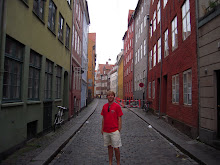The best place to start, it seems, is when Scottie is given the task of finding Madeline. His old school friend Gavin Elster calls him in, and, after relating that “San Francisco is changing” and that he “wishes he lived in the old days”, Gavin proposes a mystery for Scottie to solve: he must find out whether or not Gavin’s wife, Madeline, is being possessed by her dead great grandmother.
So off we go on at the helm of an odd request, and follow Scottie as he follows Madeline around the city, amassing a set of facts and clues and reporting back to Elster. His first real day is eventful: it takes him first to the flower shop, then to the graveyard and to the museum. Along the way, he—and we—begins to compile a list of hints about this possibly possessed woman: flower bouquet, Carlotta Valdes, portrait in the Legion of Honor. Hitchcock’s camerawork often parallels Scottie’s point of view at these moments, intertwining Scottie with us, making us feel the same heat of the case Scottie does. In the museum scene, for instance, as Madeline stares up at the painting of Carlotte Valdes, the camera zooms into Madeline’s recently purchased bouquet of flowers and then to the bouquet in the painting; it then moves from the bun in Madeline’s hair to Carlotta’s bun in the portrait. Scottie’s eyes control the camera. He and we take note of the clues.

But even as the facts build, there is an unnerving sense of unease to all of it. Everything is falling too perfectly into place, everything almost too controlled. The details spill too easily at Scottie’s feet. Scottie falls in love with his prey, but she promptly commits suicide, in sight for him to see. This launches Scottie back into an even deeper psychological hell than he first spiraled into at the film’s open. And, much to the dismay of the ever-motherly Midge Wood (a perfectly rigid and desexualized name if there ever was one), the only way Scottie can fully recover is to solve the mystery, to re-involve himself with everything Madeline. He begins to see her everywhere he goes, in every woman he sees; he obsesses over the facts that made up the case.
After all, Scottie is a detective, a policeman. “There’s an answer to everything,” he tells Midge early on in the movie. At his core, he is a man of facts. Likewise, Vertigo, at its core, is a film of facts. So when, after Scottie meets Judy and Hitchcock immediately reveals to the audience—and not Scottie—that Judy was pretending to be Madeline, that it was all a huge setup, everything immediately changes. The facts that were presented, cloaked in that eerie uneasiness, are now seen in an entirely new light. Before, as Scottie tracked Madeline down, we felt intelligent, we felt investigatory, we were hot on the case. But, in remembrance or on second viewing, we truly feel the anger Scottie feels for having been duped. As Judy divulges the truth into the letter to Scottie, the facts are now more than facts: they are instructions. These instructions have been relayed twice: first from Gavin Elster to Judy, then from Elster to Scottie. Elster sets two individuals in motion, timing their staggering perfectly in order to pull off the crime. And it all had gone to plan.
.jpg)
From here on is a far different mystery. This is the second layer of the film, the second investigation that Scottie undertakes, but this time around we know more than he does. So we watch Scottie as he puts the pieces of the puzzle back together. Perfectly ironic is the fact that Scottie’s instinct drives him to undergo a similar act of creation Judy did before. He recreates Judy into Madeline. With this action, Scottie does exactly what Gavin did. The facts build up and Scottie brings his ghostly beloved back from the dead, only to hit another roadblock when his set of facts overflow and he realizes he’s been duped. Again, he follows his instinct, bringing Judy back to the scene of the crime, leading him to witness the death of yet another.
Though it might be tough to recreate the original psychological impact of the first viewing of Vertigo, there are facts and details Hitchock sprinkles into the first two acts, his own little clues that foreshadow what’s to happen. My personal favorite occurs in the bookstore Scottie and Midge visit. He tells them of the old days of San Francisco, and the actions of Carlotta Valdes’ husband: “He kept the child and threw her away.” This time, he kept a copy and threw away the original.

No comments:
Post a Comment